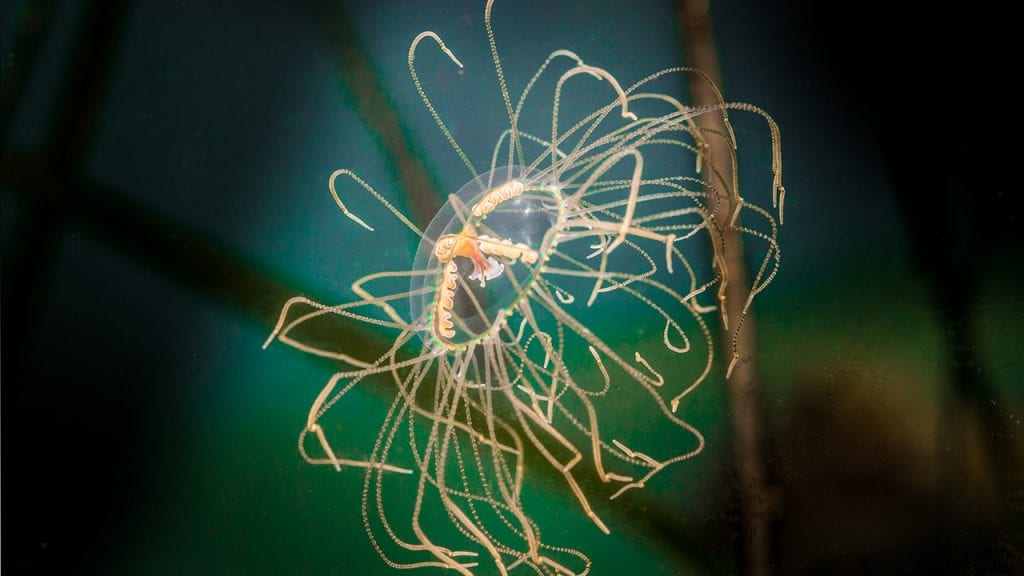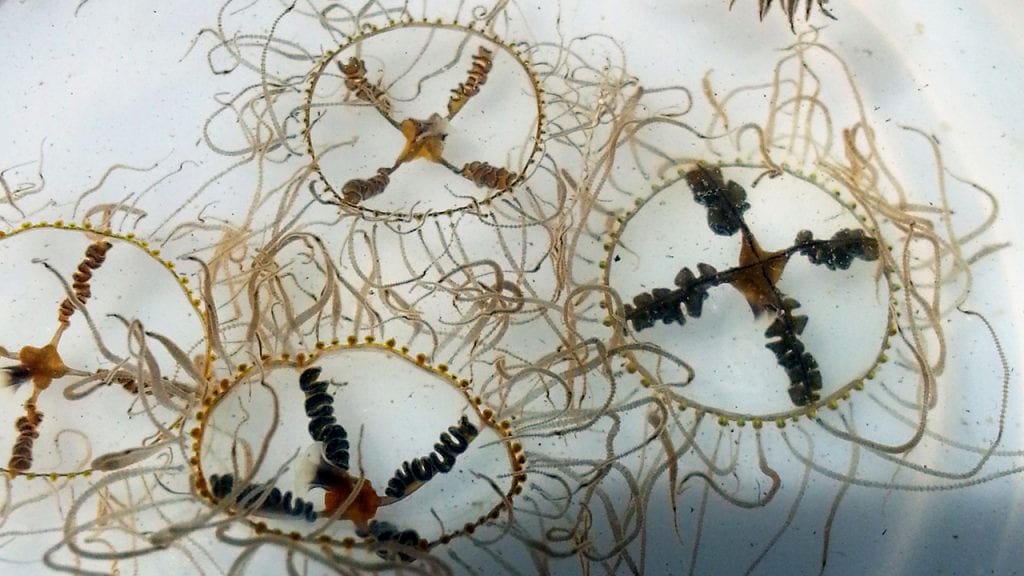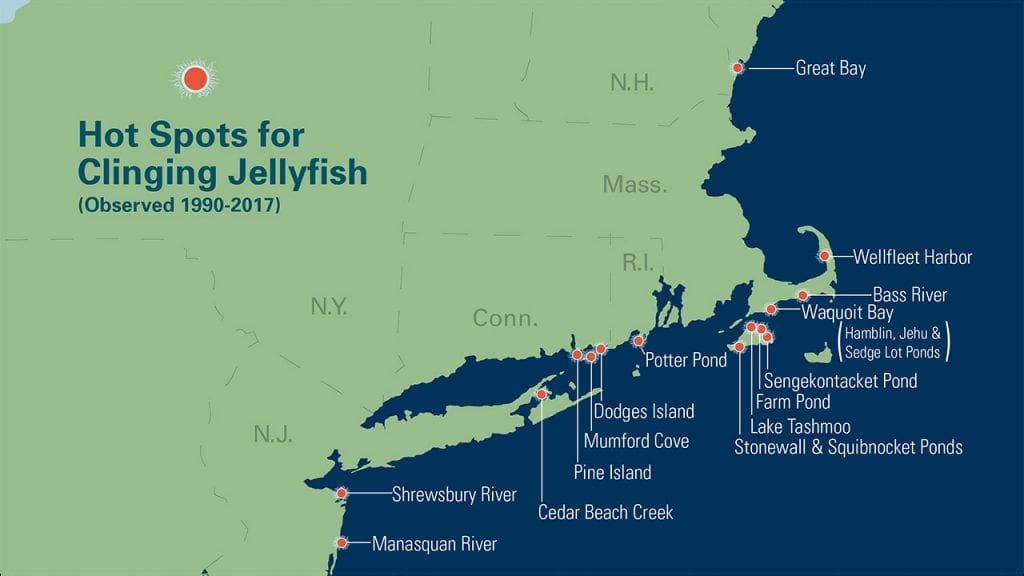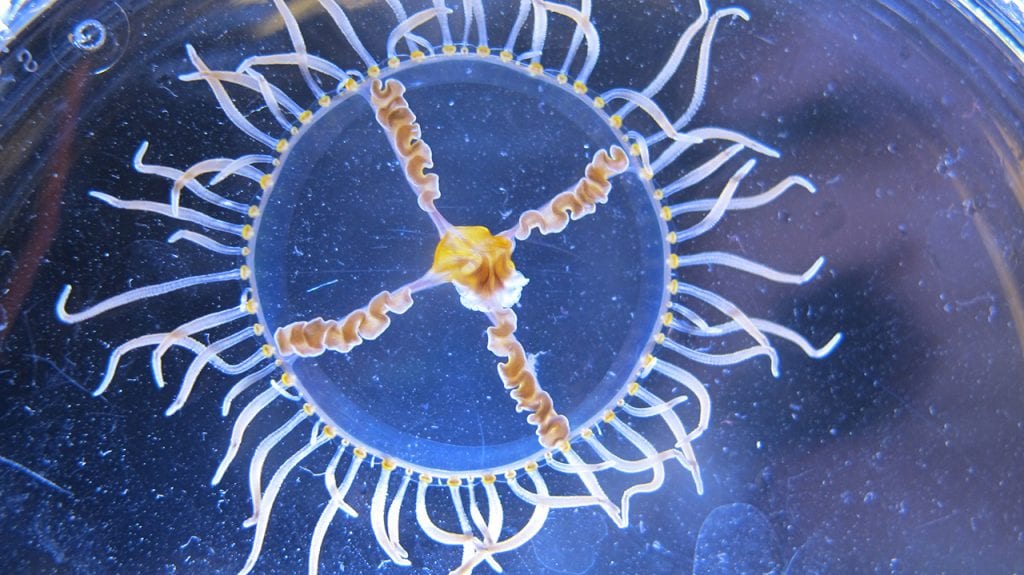FAQs: Clinging jellyfish
June 6, 2019
» Download printable version of FAQ
What are clinging jellyfish?
Clinging jellyfish (Gonionemus) are small jellies—adults are about 2.5 centimeters (~1 inch) in diameter—that have an orange-brown cross on their transparent bodies. They are known as “clinging” jellyfish because they have sticky pads on their tentacles that allow them to anchor to seagrasses and seaweeds.
Where are clinging jellyfish found?
They are found along coastlines in the Pacific and Atlantic oceans, and in particular in waters of the Peter the Great Gulf near Vladivostok, Russia, and the Sea of Japan. Long assumed to be native to the North Pacific, researchers are not sure how the jellyfish became so widely distributed throughout the world. Along the northeastern U.S. they are found primarily from eastern Connecticut to Maine, where populations may potentially contain a mix of native and introduced forms. They have also been found in one site on Long Island (Cedar Beach Creek in Southold, NY), but may not be established there. In 2016, they were found for the first time in northern New Jersey.
How long have they been in waters along the U.S. East Coast?
The clinging jellyfish were first recorded along the U.S. East Coast in the Cape Cod and the Groton, Connecticut areas in 1894. Scientists in Woods Hole studied the species intensively in the early 1900s. Following an eelgrass die-off, their numbers dwindled, and the clinging jellyfish nearly vanished in the 1930s. There were few sightings (on Martha’s Vineyard, and along the Maine coast) until 1990, when the first painful sting was reported in Cape Cod waters. Since then, there have been several more stings and the jellyfish have become abundant in several locations.
When do clinging jellyfish appear on the U.S. East Coast?
The animals bloom in the summer months. In Cape Cod waters, blooms begin in mid-to-late June and continue through early September. The bloom season may start and end earlier farther south. Clinging jellyfish are produced by microscopic polyps, which are about a millimeter or less in size. Animals survive as polyps or other microscopic stages in other parts of the year.
I like to surf and swim at the beach. Should I be worried?
Swimmers and beachgoers shouldn’t be overly concerned. Clinging jellyfish are not usually found in high-energy environments, such as beaches exposed to strong ocean waves. Researchers say they generally only see clinging jellyfish in calm, quiet areas where eelgrass or seaweeds grow. Occasionally, they are found in association with seaweeds around floating docks.
How toxic are stings from clinging jellyfish?
While the stings are known to be quite painful, toxicity seems to vary by region. Scientists suspect there are several types of Gonionemus jellies and that some types might cause more painful stings than others. Additionally, people may respond to the stings differently, with some being more sensitive to stings than others. Reactions to stings can range from no discomfort to severe pain, redness at the sting site, and respiratory and/or neurological symptoms. Symptoms can last three to five days. While the sting symptoms can be severe, WHOI researchers are not aware of any documented fatalities associated with US or Sea of Japan populations.
What should I do if I get stung by a clinging jellyfish?
While we cannot dispense medical advice, WHOI researchers suggest that you seek medical treatment if you feel it is necessary.
If you see a clinging jellyfish, avoid contact with it. Do not handle the jellyfish or collect it. Please send an email to our researchers with the specific location of the sighting and an image, if possible, to jellyfish@whoi.edu.
Additional resources
More information about research on clinging jellyfish can be found on these sites:
“Know Your Ocean” Jellyfish & Other Zooplankton
Tracing the Puzzling Origins of Clinging Jellyfish
Study Discovers Surprising Genetic Links Among Communities
Mysterious Jellyfish Makes a Comeback
Rise in toxic stings has scientists on the alert
Dr. Annette Frese Govindarajan
“Mitochondrial diversity in Gonionemus (Trachylina:Hydrozoa) and its implications for understanding the origins of clinging jellyfish in the Northwest Atlantic Ocean,”
published in the journal Peer
“Possible cryptic invasion of the Western Pacific toxic population of the hydromedusa Gonionemus vertens (Cnidaria: Hydrozoa) in the Northwestern Atlantic Ocean,”
published in the journal Biological Invasions




